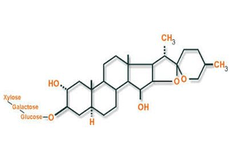SAPONINS, GLYCOSIDES AND FLAVONOIDS IN CELLS AND TISSUES OF BALANITES AEGYPTIACA CULTURED ON SOLID AND LIQUID CULTURE MEDIA
Keywords:
Biotechnology, desert palm, phytopharmaceutics, plant tissue culture, secondary metabolitesAbstract
Objectives: The main objective of the present study is to obtain callus and cell suspension culture from Balanitesa egyptiaca sterile plantlets grown in vitro and to compare growth and the biosynthetic potential of saponins, flavonoids and glycosides by callus and cell suspension culture Balanitisa egyptiaca.
Methods: Callus was induced from the mother plants on MS culture media supplemented with 2.0 mg/l BA + 2.0 mg/l 2,4-D with and without agar gelling. Total saponins, glycosides and flavonoids were estimated in both types of cultures over a period extending from 1 to 5 weeks to compare the productivity of such secondary metabolites in callus and cell suspension cultures.
Results: The results obtained indicated that both calli and cell suspension cultures were able to synthesize the target active ingredients and that cell suspension culture was superior to the callus culture in the biosynthesis and accumulation processes. By the end of the incubation period, the amount of total saponins in cell suspension culture reached up 51.97±0.26 dry biomass compared to 35.02 ±0.06 mg/g in callus culture. The amount of total flavonoids in cell suspension culture reached up 10.88±0.24 dry biomass compared to 6.40±0.02 mg/g in callus culture and of total glycosides reached up 6.11±0.25 dry biomass compared to 5.06 ±0.05 mg/g in callus culture.
Conclusions: The results obtained in this study may indicate the promising role that plant cell culture will play in the future in phytopharmaceutical industry.

Peer Review History:
Received 7 June 2020; Revised 15 July; Accepted 20 August; Available online 15 September 2020
Academic Editor:
Dr. Iman Muhammad Higazy , National Research Center, Egypt, imane.higazy@hotmail.com
, National Research Center, Egypt, imane.higazy@hotmail.com
Reviewer(s) detail:
Dr. Gehan Fawzy Abdel Raoof Kandeel , Researcher at pharmacognosy Department, National Research Centre, Egypt, gehankandeel9@yahoo.com
, Researcher at pharmacognosy Department, National Research Centre, Egypt, gehankandeel9@yahoo.com
Ahmad Najib , Department of Pharmacognosy-Phytochemystry Universitas Muslim Indonesia-Indonesia, ahmad.najib@umi.ac.id
, Department of Pharmacognosy-Phytochemystry Universitas Muslim Indonesia-Indonesia, ahmad.najib@umi.ac.id
Downloads

Published
How to Cite
Issue
Section

This work is licensed under a Creative Commons Attribution-NonCommercial 4.0 International License.









 .
.